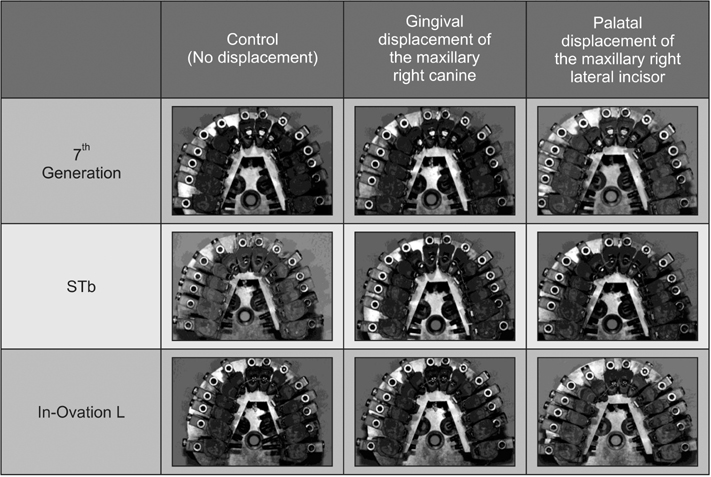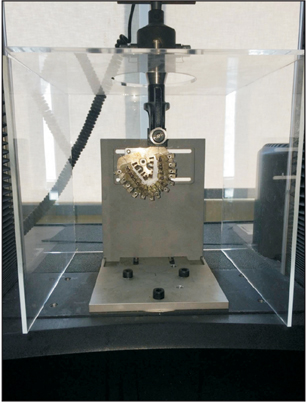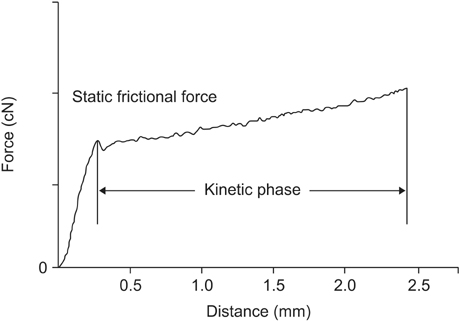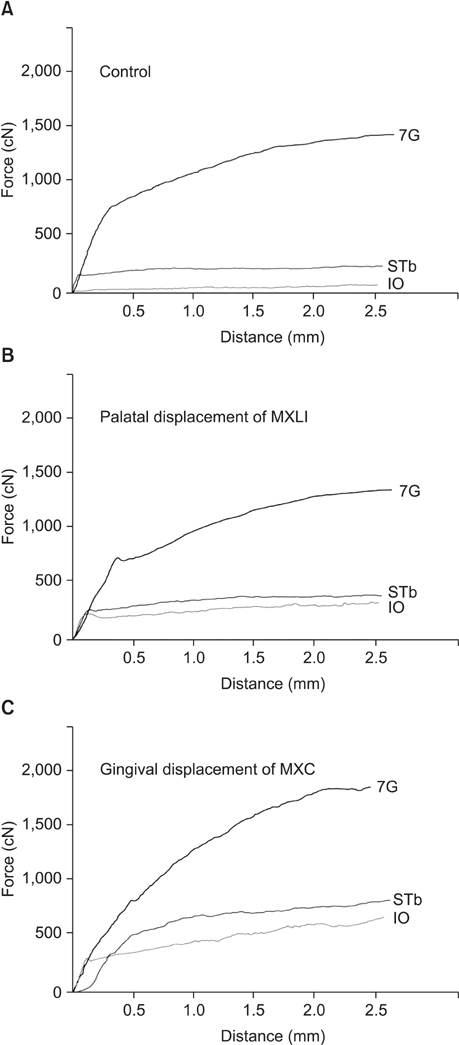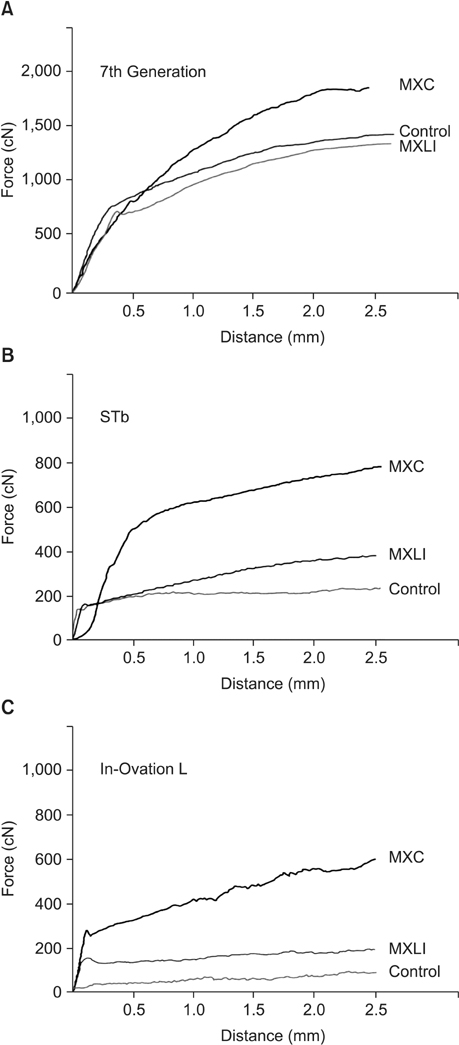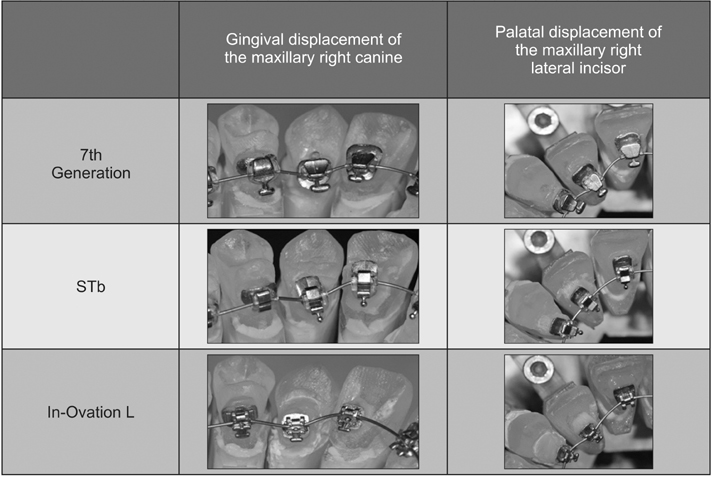Korean J Orthod.
2016 Mar;46(2):87-95. 10.4041/kjod.2016.46.2.87.
Frictional property comparisons of conventional and self-ligating lingual brackets according to tooth displacement during initial leveling and alignment: an in vitro mechanical study
- Affiliations
-
- 1Department of Orthodontics, School of Dentistry, Seoul National University, Seoul, Korea. drwhite@unitel.co.kr
- 2Department of Biomaterials Science, School of Dentistry, Seoul National University, Seoul, Korea.
- 3Dental Research Institute, Seoul National University, Seoul, Korea.
- KMID: 2159356
- DOI: http://doi.org/10.4041/kjod.2016.46.2.87
Abstract
OBJECTIVE
We evaluated the effects of tooth displacement on frictional force when conventional ligating lingual brackets (CL-LBs), CL-LBs with a narrow bracket width, and self-ligating lingual brackets (SL-LBs) were used with initial leveling and alignment wires.
METHODS
CL-LBs (7th Generation), CL-LBs with a narrow bracket width (STb), and SL-LBs (In-Ovation L) were tested under three tooth displacement conditions: no displacement (control); a 2-mm palatal displacement (PD) of the maxillary right lateral incisor (MXLI); and a 2-mm gingival displacement (GD) of the maxillary right canine (MXC) (nine groups, n = 7 per group). A stereolithographic typodont system and artificial saliva were used. Static and kinetic frictional forces (SFF and KFF, respectively) were measured while drawing a 0.013-inch copper-nickel-titanium archwire through brackets at 0.5 mm/min for 5 minutes at 36.5℃.
RESULTS
The In-Ovation L exhibited lower SFF under control conditions and lower KFF under all displacement conditions than the 7th Generation and STb (all p < 0.001). No significant difference in SFF existed between the In-Ovation L and STb for a 2-mm GD of the MXC and 2-mm PD of the MXLI. A 2-mm GD of the MXC produced higher SFF and KFF than a 2-mm PD of the MXLI in all brackets (all p < 0.001).
CONCLUSIONS
CL-LBs with narrow bracket widths exhibited higher KFF than SL-LBs under tooth displacement conditions. CL-LBs and ligation methods should be developed to produce SFF and KFF as low as those in SL-LBs during the initial and leveling stage.
Figure
Cited by 1 articles
-
In-vitro investigation of the mechanical friction properties of a computer-aided design and computer-aided manufacturing lingual bracket system under diverse tooth displacement condition
Do-Yoon Kim, Sang-Woon Ha, Il-Sik Cho, Il-Hyung Yang, Seung-Hak Baek
Korean J Orthod. 2019;49(2):73-80. doi: 10.4041/kjod.2019.49.2.73.
Reference
-
1. Fujita K. New orthodontic treatment with lingual bracket mushroom arch wire appliance. Am J Orthod. 1979; 76:657–675.
Article2. Smith JR, Gorman JC, Kurz C, Dunn RM. Keys to success in lingual therapy. Part 1. J Clin Orthod. 1986; 20:252–261.3. Creekmore T. Lingual orthodontics--its renaissance. Am J Orthod Dentofacial Orthop. 1989; 96:120–137.
Article4. Moran KI. Relative wire stiffness due to lingual versus labial interbracket distance. Am J Orthod Dentofacial Orthop. 1987; 92:24–32.
Article5. Takemoto K. Lingual orthodontics extraction therapy. Clin Impr. 1995; 4:2–7. 18–21.6. Geron S. Finishing with lingual appliances, problems and solutions. Semin Orthod. 2006; 12:191–202.
Article7. Lombardo L, Arreghini A, Al Ardha K, Scuzzo G, Takemoto K, Siciliani G. Wire load-deflection characteristics relative to different types of brackets. Int Orthod. 2011; 9:120–139.
Article8. Khattab TZ, Farah H, Al-Sabbagh R, Hajeer MY, Haj-Hamed Y. Speech performance and oral impairments with lingual and labial orthodontic appliances in the first stage of fixed treatment. Angle Orthod. 2013; 83:519–526.
Article9. Park KH, Bayome M, Park JH, Lee JW, Baek SH, Kook YA. New classification of lingual arch form in normal occlusion using three dimensional virtual models. Korean J Orthod. 2015; 45:74–81.
Article10. Kusy RP, Whitley JQ. Resistance to sliding of orthodontic appliances in the dry and wet states: influence of archwire alloy, interbracket distance, and bracket engagement. J Biomed Mater Res. 2000; 52:797–811.
Article11. Kim TK, Kim KD, Baek SH. Comparison of frictional forces during the initial leveling stage in various combinations of self-ligating brackets and archwires with a custom-designed typodont system. Am J Orthod Dentofacial Orthop. 2008; 133:187.e15–187.e24.
Article12. Heo W, Baek SH. Friction properties according to vertical and horizontal tooth displacement and bracket type during initial leveling and alignment. Angle Orthod. 2011; 81:653–661.
Article13. Lombardo L, Wierusz W, Toscano D, Lapenta R, Kaplan A, Siciliani G. Frictional resistance exerted by different lingual and labial brackets: an in vitro study. Prog Orthod. 2013; 14:37.
Article14. Celikoglu M, Bayram M, Nur M, Kilkis D. Mandibular changes during initial alignment with SmartClip self-ligating and conventional brackets: a single-center prospective randomized controlled clinical trial. Korean J Orthod. 2015; 45:89–94.
Article15. Henao SP, Kusy RP. Evaluation of the frictional resistance of conventional and self-ligating bracket designs using standardized archwires and dental typodonts. Angle Orthod. 2004; 74:202–211.16. Henao SP, Kusy RP. Frictional evaluations of dental typodont models using four self-ligating designs and a conventional design. Angle Orthod. 2005; 75:75–85.17. Seo YJ, Lim BS, Park YG, Yang IH, Ahn SJ, Kim TW, et al. Effect of self-ligating bracket type and vibration on frictional force and stick-slip phenomenon in diverse tooth displacement conditions: an in vitro mechanical analysis. Eur J Orthod. 2015; 37:474–480.
Article18. Seo YJ, Lim BS, Park YG, Yang IH, Ahn SJ, Kim TW, et al. Effect of tooth displacement and vibration on frictional force and stick-slip phenomenon in conventional brackets: a preliminary in vitro mechanical analysis. Eur J Orthod. 2015; 37:158–163.
Article19. Park JH, Lee YK, Lim BS, Kim CW. Frictional forces between lingual brackets and archwires measured by a friction tester. Angle Orthod. 2004; 74:816–824.20. Ozturk Ortan Y, Yurdakuloglu Arslan T, Aydemir B. A comparative in vitro study of frictional resistance between lingual brackets and stainless steel archwires. Eur J Orthod. 2012; 34:119–125.
Article21. Scuzzo G, Takemoto K, Takemoto Y, Takemoto A, Lombardo L. A new lingual straight-wire technique. J Clin Orthod. 2010; 44:114–123.22. Scuzzo G, Takemoto K, Takemoto Y, Scuzzo G, Lombardo L. A new self-ligating lingual bracket with square slots. J Clin Orthod. 2011; 45:682–690.23. Xia Z, Chen J. Biomechanical validation of an artificial tooth-periodontal ligament-bone complex for in vitro orthodontic load measurement. Angle Orthod. 2013; 83:410–417.
Article
- Full Text Links
- Actions
-
Cited
- CITED
-
- Close
- Share
- Similar articles
-
- A comparative study of frictional force in self-ligating brackets according to the bracket-archwire angulation, bracket material, and wire type
- Effect of different combinations of bracket, archwire and ligature on resistance to sliding and axial rotational control during the first stage of orthodontic treatment: An in-vitro study
- Clinical considerations with self-ligating brackets
- Mandibular changes during initial alignment with SmartClip self-ligating and conventional brackets: A single-center prospective randomized controlled clinical trial
- In-vitro investigation of the mechanical friction properties of a computer-aided design and computer-aided manufacturing lingual bracket system under diverse tooth displacement condition

